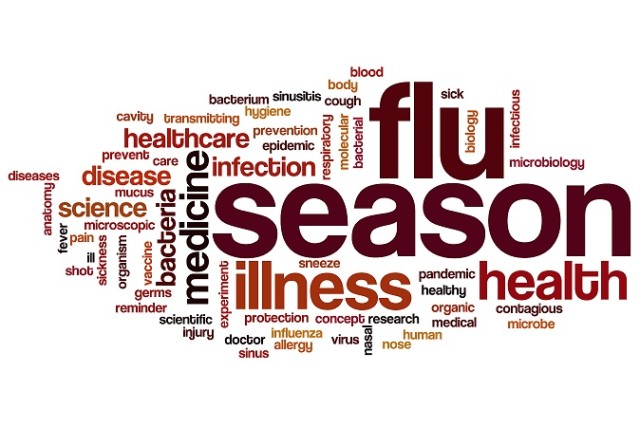

As we age, we need to make more of an effort to stay well. “Adults 65 and older are more susceptible to the flu than younger folks,” says Joseph Ladapo, M.D., Ph.D., an internal medicine specialist at UCLA. “So taking precautions is important.”
This starts with the obvious:

Wash your hands. Do it well, and do it often. Scrub your hands together—including the back of your hands, between your fingers, and under your nails—for at least 20 seconds. It’s a proven way to help prevent illness and the spread of infection.
With those bases covered, you’re off to a good start. But to maximize your chances of staying well all season, adopt the simple strategies below. All are proven to be effective yet often overlooked.
1. Use Paper Towels

During cold and flu season, Gerba suggests using paper towels instead—in the bathroom and the kitchen. Also, use paper towels to clean countertops, as a sponge can also spread germs. Check out more ways to protect yourself from hidden dangers in your house.
2. Serve Breakfast in Bed—the Guest Bed
Whenever Gerba’s wife is under the weather, he brings her meals in bed. Sweet, right? He has an ulterior motive: It keeps her from infecting the kitchen.
“Sick people can transfer a cold or flu virus to other household members within as little as four hours,” Gerba says. What’s more, if a member of your household has the flu, your chances of getting sick go up by 38 percent, according to a 2016 Trends in Microbiology report.
The flu virus doesn’t just spread through shared objects, like hand towels. It can also travel via droplets through the air—up to six feet.
Your move: Quarantine any sick members of your household, and try to keep your distance, especially if they’re coughing or sneezing.
3. Wipe Down the Remote

When you touch hard surfaces like remotes, phones, or doorknobs, about half the germs can transfer to your hands, Gerba says. And viruses can survive on these surfaces for several days.
To reduce your risk of picking up a bug, sanitize hot spots with wipes that say “disinfecting” on the label, and be sure to follow the instructions. Staying at a hotel? Put the remote inside a plastic baggie to provide a protective layer.
4. Strategically Place Hand Sanitizer Everywhere

In one 2014 study, researchers contaminated the hands of one adult in each of seven different households with a bacterial virus. They then placed alcohol-based hand sanitizer around the house (kitchen, bathrooms, nurseries) and instructed family members to use it one to three times throughout the day.
After eight hours, using hand sanitizer resulted in 99 percent fewer viruses on family members’ hands. There were also fewer viruses on household surfaces, like counters, faucets, and light switches.
“It’s a great strategy,” Gerba says, “because a sick person may not want to get out of bed to wash their hands.”
Look for a sanitizer with at least 70 percent alcohol, like Purell Advanced Instant Hand Sanitizer. “The alcohol will dissolve influenza’s fatty outer layer,” Gerba explains.
5. Take the Stairs
The most germ-infested elevator button of all: first floor, Gerba says. It makes sense. It’s the button everyone must press.
If you can, take the stairs instead. Another option: Push the button with your knuckle, and then break out that hand sanitizer.
6. Trade Leather Gloves for Cotton or Wool (and Wash Them)
Many people think it’s safer to touch your face with a gloved hand than a bare one, but gloves can still pick up germs, Gerba says. Leather gloves may transfer germs even more easily than cotton or wool, he adds.
That’s because cotton and wool are more porous. If a virus burrows into the fibers, it won’t easily get out. Plus, those materials are easier to wash, which you should do regularly in hot water.
7. Get Some Fresh Air Every Day

“Cold weather can be isolating for older adults,” says Navjot Jain, D.O., an internal medicine specialist at Ohio State University. “And that can make them susceptible to depression, which suppresses the immune system.”
What’s more, studies show that regular exercise can reduce your risk of an upper respiratory infection. When researchers tracked 1,000 adults during the winter months, they found those who exercised at least five days per week were 43 percent less likely to get sick than people who exercised only one day or less.
You don’t have to do an intense workout every day. Aim to go for a brisk 20-minute walk five days per week. And remember to dress appropriately for cold weather, and be careful if it’s icy, Dr. Jain cautions.
If outdoor activity isn’t safe or practical, hop on the treadmill, recumbent bike, elliptical, or into an indoor pool. Or try these do-anywhere ideas:
- 8-Minute Cardio Flow and Go
- The Total-Body Resistance Band Workout
- 4 Exercises You Should Do Every Day
8. Embrace the Fist Bump
About 30 percent of people with the common cold have the virus on their hands, most likely on the fingertips, Gerba says.
Minimize your hand-to-hand contact by avoiding handshakes and making the fist bump your go-to greeting during cold and flu season. Bonus: You’ll score cool points with your grandkids.
9. Use a Humidifier

A study published in the journal PLOS One found that higher humidity levels indoors (between 40 and 45 percent humidity) can significantly reduce the spread of influenza virus. When researchers released viral particles in a room at a relative humidity of 23 percent or less, 70 to 77 percent retained their infectious capacity. When humidity was increased to about 43 percent, only 14 percent of the virus particles were capable of infecting cells.
The takeaway: Humidifying indoor air may help decrease the spread of the flu. Keep it between 40 and 45 percent humidity; more humidity than that doesn’t provide additional flu-fighting benefits and may increase the risk of mold. Plus, keep mold away by cleaning your humidifier with plain dish soap and hot water at least every third day.
10. Skip Your Weekly Card Game
Research shows the cold virus can be transmitted by playing cards with someone who’s sick. “The virus can get on the cards and be passed around, infecting other players,” Gerba says.
Don’t want to give up games all season? At least keep hand sanitizer at the table. Or maybe just play charades instead.
Source: Silver Sneakers












